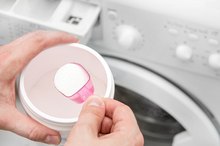What Is the Blue Stuff in Reusable Cold Packs?
Reusable cold packs have made cooling bumps and bruises or relieving pain more convenient than using ice wrapped in towels. In addition to first-aid uses, these packs can help keep food cool for hours when traveling or taking a day trip or even shipping food or refrigerated medicine. While the packs may melt, the contents will not leave the same wet mess as melted ice. The contents found in blue ice packs consist of water that is mixed with ammonium nitrate fertilizer or a combination of other chemicals 1.
Ammonium Nitrate Fertilizer
Used commonly by farmers, this fertilizer is made of nitrogen and calcium carbonate. Used in instant cold packs, an endothermic reaction (a reaction that absorbs heat) occurs when the pack is cracked and shaken and the temperature of the packs drops to approximately 35 degrees Fahrenheit for 10 to 15 minutes. Although useful as a fertilizer for the farming community as well, the unstable combination of these chemicals can also lead to dangerous accidents and harmful events. For example, in 1995, this fertilizer was ignited in the Oklahoma City Bombing, which razed the city’s Federal Building and killed several hundred people.
- Used commonly by farmers, this fertilizer is made of nitrogen and calcium carbonate.
- Used in instant cold packs, an endothermic reaction (a reaction that absorbs heat) occurs when the pack is cracked and shaken and the temperature of the packs drops to approximately 35 degrees Fahrenheit for 10 to 15 minutes.
Reusable Cold Packs
Chemicals Used in a Cold Pack
Learn More
The more common reusable cold packs have a blue gel contained in a sealed bag. According to the 3M Reusable Cold Packs Material Safety Data Sheet (MSDS), these noncombustible ingredients are primarily water (60 to 70 percent), propylene glycol (20 to 35 percent) and sodium carboxymethyl cellulose (less than 5 percent), with a polypropylene cover.
Toxicity
Although advertised as nontoxic, the chemicals contained in a reusable cold pack may cause:
- mild eye irritation
- localized redness of skin or
- if ingested
- abdominal pain
- stomach upset
- nausea
- vomiting
- diarrhea
Side effects of ingestion may include
- headache
- dizziness
- drowsiness
- lack of coordination
- nausea
- slowed reaction time
- among others
First Aid
What Chemicals Are in Hot & Cold Packs?
Learn More
It is advised to seek medical attention if the contents of a reusable cold pack come in contact with the skin or eyes or is ingested. If contact is made to the eyes or skin, wash with large amounts of water. If ingested, do not induce vomiting. Rather, give the victim two glasses of water and seek medical attention. If the victim is unconscious, seek medical attention prior to anything else.
- It is advised to seek medical attention if the contents of a reusable cold pack come in contact with the skin or eyes or is ingested.
- If the victim is unconscious, seek medical attention prior to anything else.
Homemade Cold Packs
To make your own cold pack, add 3 cups of water and 1 cup of isopropyl alcohol to a zip-locking plastic bag. Close the bag and insert it into another zip-locking bag. Place it in the freezer. The contents will become a slushy frozen mixture. A cloth should be used over the cold pack when applying it to the skin.
- To make your own cold pack, add 3 cups of water and 1 cup of isopropyl alcohol to a zip-locking plastic bag.
Related Articles
References
Writer Bio
Aimée D. O’Grady graduated from George Mason University in 2006 with a master’s degree in professional writing and editing. She obtained a B.A. from Siena College in 1998 with a major in French and a minor in art history.









